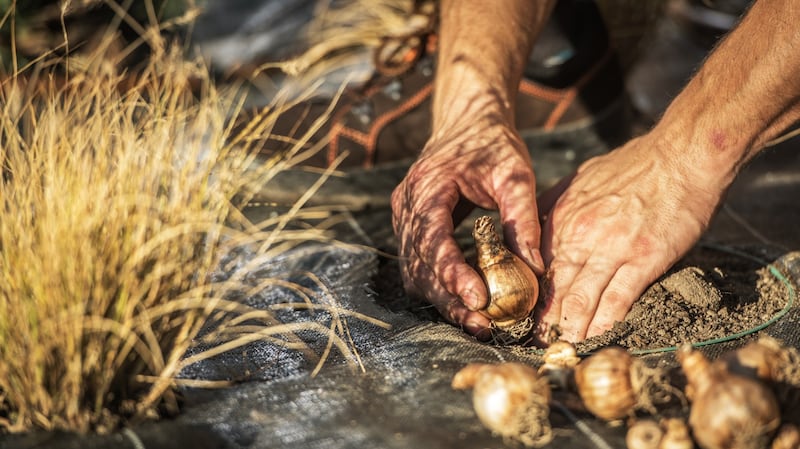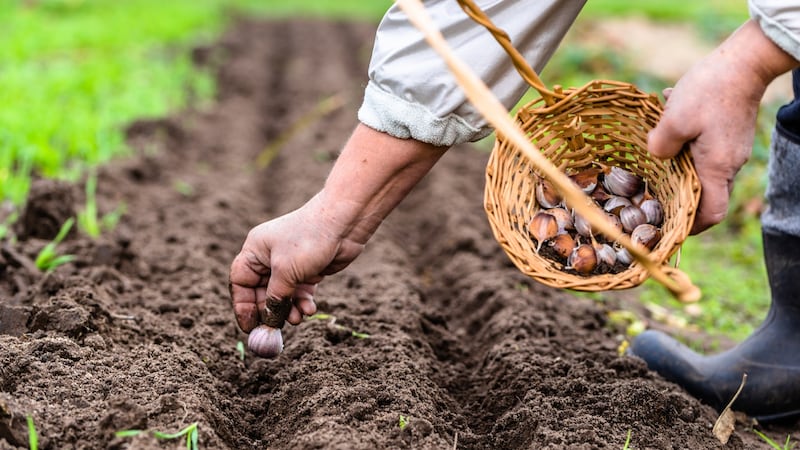1. Make some leaf mould
As autumn leaves come tumbling down, now is the time to put that natural beauty to good use in your garden or allotment. Leaf mould is a brilliant, nature-friendly soil conditioner that improves the structure of garden soils, adds organic matter, boosts the activity of beneficial soil organisms and supports plant health, and making your own leaf mould couldn’t be easier.
Start by collecting the fallen leaves of deciduous trees and packing them tightly (but not too tightly) into plastic bin bags. Sprinkle a little water over the leaves if they’re dry, then tie the tops of the bags before using a garden fork to spike plenty of small holes right across their surface. This allows fresh air to circulate, which along with moisture is crucial for the sort of beneficial fungal activity required to rot down the leaves.
Place the bags in a cool, shady, out-of-the-way corner of the garden where the leaves will gradually rot down, a process that takes anywhere from 2-3 years. The resulting leaf mould can be lightly dug into soils, used as a surface mulch or added to potting compost mixes for pots and containers.
2. Plant spring-flowering bulbs

Few things are easier to grow than spring-flowering bulbs; simply tuck them into the ground or in pots and up they’ll come like magic next spring. Many also make excellent cut-flowers including tulips, narcissus, crown imperials (Fritillaria imperialis) and alliums, all of which can be planted (but hurry) at this time of year.
There’s also still time to plant many different kinds of smaller spring-flowering bulbs including crocus, scillas, Anemone blanda, chionodoxa and grape hyacinths, all of which can be planted densely into pots (for successional colour, plant in layers, using what’s known as the “lasagne method”, with the smallest, earliest flowering varieties to the top) or into lawns and borders.
3. Sow sweet pea
Sow seed of sweet pea for early-flowering, vigorous, floriferous plants to plant out into the garden or allotment next spring. For best results, pre-chit the seed by placing it in damp kitchen paper in a small plastic box/container. Once you spot signs of germination, very gently sow the individual seeds into root-trainers (available to order online from mrmiddleton.ie, quickcrop.ie and fruithillfarm.com), water gently and then move to an unheated glasshouse or a cool, bright spot outdoors, making sure to take precautions against mice and slugs.
Recommended seed stockists include all good Irish garden centres along with specialist online suppliers such as somersetsweetpeas.com and rpsweetpeas.com
4 . Seek out bare-root specimens
November marks the beginning of the bare-root season with many kinds of woody and perennial plants available as bare-root specimens for a fraction of the price that they’d cost as potted specimens. Bare-root plants are also kinder to the environment (there’s much less plastic packaging), easier to transport (they’re lighter and less bulky) and easier to plant (their root systems typically don’t require as big or as deep a planting hole as container-grown plants), making them a particularly good choice for larger-scale garden plantings such a hedge or mini-woodland.
Recommended suppliers include all good Irish garden centres, most of which are taking orders online. In particular, check out Cork-based Future Forests which specialises in the mail-order supply of a very wide range of ornamental and fruiting varieties of bare-root trees and shrubs (futureforests.com). Other Irish nurseries that carry a generous range of bare-root plants include Wicklow-based Cappagh Nurseries (vanderwel.ie) and Cork-based MacNamara Roses (021-4613733)
5. Put some winter containers in place
Just a few handsome, well-planted, well-positioned winter containers can do wonders when it comes to adding cheer and seasonal interest to the winter garden. For best results, fill them with a good-quality John Innes-based compost before planting them up with a variety of hardy species with the focus firmly on handsome architectural, evergreen foliage and textural interest.
To give plenty of visual impact, choose plants with contrasting growth habits (for example trailing ivies, clump-forming perennials such as hellebores, heathers, heucheras and evergreen ferns, and ornamental evergreen grasses. For pops of bright colour, add some winter bedding (violas, polyanthus and cyclamen are good for mild, sheltered gardens) and some spring-flowering bulbs.
For maximum impact and enjoyment, position your winter pots in a cluster in a bright, sheltered spot close to an often-used doorway/garden gate or in easy view of a window.
6. Grow your own garlic

For best results, source plump, healthy, blemish-free seed garlic as bulbs from garden centres or specialist suppliers such as quickcrop.ie and fruithillfarm.com. Gently separate the bulbs into individual cloves before planting them, pointy end up, into a fertile, weed-free, free-draining soil in a sunny spot in the garden or allotment. Space the individual cloves 10-20cm apart with 30cm between rows and to a depth where the tip of the clove is 2.5cm-5cm below ground level.
Varieties suitable for autumn planting include Vallelado, Red Duke, Lautrec Rose, Lautrec Wight (very flavoursome but only suitable for sheltered gardens with well-drained soils), Morado and Chesnok Red (all hardneck types), as well as softneck types such as Germidour Arno, Marco, Messidor, Thermidrome, Messidrome, Solent Wight and Cristo.
7. Take some hardwood cuttings
This is a great time of year to propagate your own plants for free by taking hardwood cuttings of a wide range of ornamental shrubs, soft fruit bushes and roses. Use a sharp secateurs or knife to take young, healthy, non-flowering cuttings (15-30cm long and no thicker than a pencil) from the parent plant, cutting just below a leaf node. Strip off the lower leaves and then either plunge the upright cuttings two-thirds deep into a plastic pot filled with a good quality seed and cuttings compost or “plant” them into fertile, free-draining, well-prepared soil in the garden, water well and label.
Hardwood cuttings typically take several months to root so be patient; by next spring they should start bursting into growth at which point they can be individually potted or planted out.
8. Grow your own micro-greens
Add flavour, colour and health-boosting phytonutrients to salads, sandwiches, soups, stir-fries, juices and smoothies by growing your own micro-greens or micro-leaves in trays/pots indoors on a bright windowsill, in a frost-free conservatory or on a heated propagating bench in a polytunnel/glasshouse.
It’s a great way of using up any old seed packets close to their sow-by date, and many kinds of herbs and vegetables are suitable for growing this way including coriander, oriental salad leaves, alfalfa, beetroot, basil, dill, amaranth, sorrel, sunflowers, watercress, perilla, peas, broccoli, kohlrabi, kale, leaf radish, fenugreek, rocket, celery leaf, chard, carrot, chives, mint, mizuna, mibuna, komatsuna, tatsoi, summer savory, onion, leek, salsola and cabbage.
Sow the seed generously into shallow trays or window boxes filled with damp (but not sodden) seed compost, water lightly and cover with a plastic lid or cling-film until you see signs of germination, which can take between seven and 28 days. Micro leaves are typically ready to eat when they're 5-10cm tall and have produced their first set of true leaves. Recommended seed stockists include greenvegetableseeds.com, brownenvelopeseeds.com and seedaholic.com
9. Plant a living willow structure
Hone your creative skills and have some fun by planting a living willow structure, a supremely eco-friendly, affordable way to create a wide variety of garden structures from sculptural garden pods, arches, fences, “fedges”, domes, tunnels, play-huts, labyrinths, wigwams, pergolas, arbours, chairs and plant supports to a giant willow castle and “fantastical beasts” including centaurs, enormous snakes, caterpillars and towering wickermen.
Unrooted willow "rods" or "wands" (planted 15cm deep into the ground, these will root surprisingly quickly) are available from most professional Irish willow weavers/artists including Kildare-based Willow Wonder (willowwonder.net) and Meath-based Newgrange Willow Design (newgrangewillowdesign.com). Willow does best in a fertile, weed-free, moisture-retentive soil in full sun/light shade. Varieties suitable for living willow structures include Salix alba var. vitellina (golden willow), S. daphnoides, S. alba "Britzensis", S. viminalis and S. purpurea.
10. Stay in bloom through winter

Dodge the winter blues by planting some flower bulbs in pots under cover for forcing into quick and early bloom in the months ahead. Varieties suitable for forcing in this way include the intensely perfumed paperwhites (examples include Narcissus “Ziva” and Narcissus “Inbal”) and hippeastrum (better known as amaryllis), which are available in a wide range of colourful varieties.
Stockists include most good Irish garden centres including johnstowngardencentre.ie and mrmiddleton.com
















